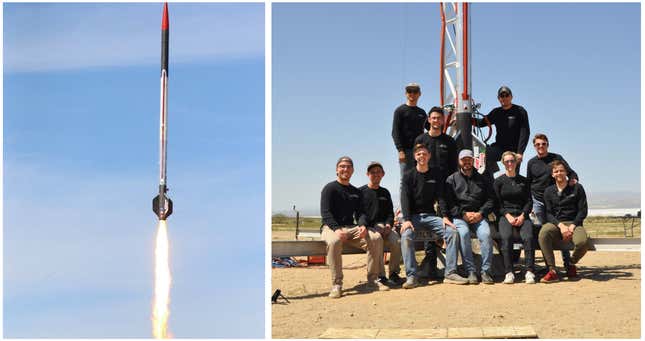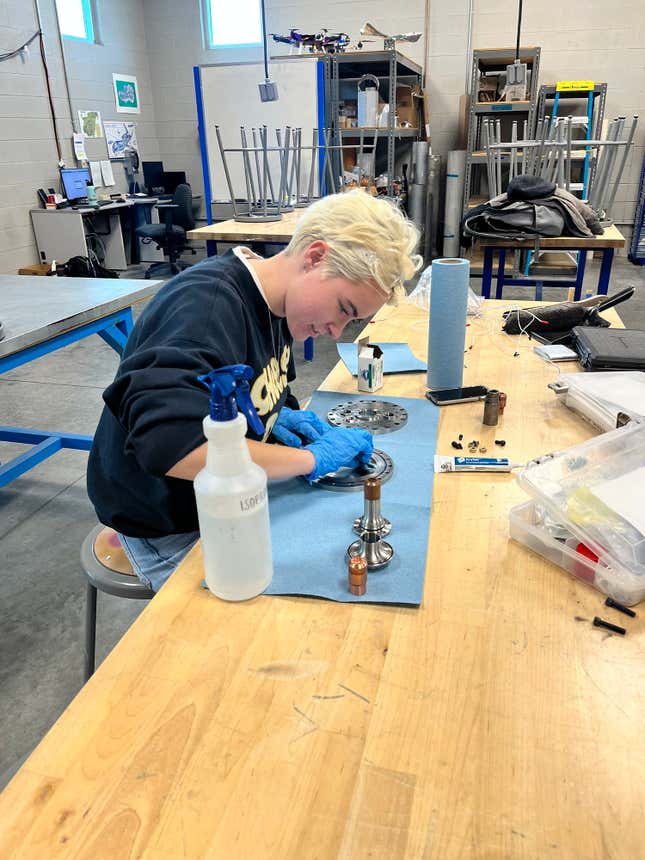They call themselves the Cygnus Suborbitals, a team of nine undergraduate students from Embry-Riddle Aeronautical University’s Prescott Campus. In April, the team sent a rocket on a record-breaking flight, pushing the boundaries for student-led projects.
The rocket, called Deneb, took off from the Friends of Amateur Rocketry facility in California’s Mojave Desert, clearing the launch tower at 9:42 a.m. local time on April 16, 2023. Deneb, with a total burn time of 26.1 seconds, reached an apogee of 47,732 feet (14.55 kilometers) while attaining a top speed of 1,150 miles per hour (1,851 km/hr). The rocket was named after Deneb, the brightest star in the Cygnus constellation.
According to an Embry-Riddle statement, it’s the “highest undergraduate and collegiate amateur liquid rocket launch in the United States,” and it more than doubled the previous record of 22,000 feet (6.7 km), set by students at the University of California, Los Angeles. Deneb also broke the amateur rocketry record, according to the team. The nine students responsible for designing, building, and testing Deneb spent 4,000 hours over the past year on the project. The team had to spend an extra night in the desert after failing to launch the rocket on three attempts during the previous day.

“I fell to my knees, sobbing, from witnessing such an incredible feat,” Dalton Songer, team leader and aerospace engineering student, said in the statement. “Everyone was celebrating in a giant group hug. That moment was special. Something that only happens when a dedicated group of individuals come together and make something incredible happen against all odds.”
For context, Deneb flew much higher than Mount Everest, which stands 29,032 feet tall (8.8 km), and higher than commercial airliners, which fly no higher than 42,000 feet (12.8 km).
Previous student-built rockets have flown higher than Deneb. Much higher. The Traveler IV rocket built by students from the University of Southern California technically flew to space, soaring above the 62-mile-high (100-km) Kármán Line in April 2019. But Traveler IV was a solid fuel rocket, which is far simpler, cheaper, and less dangerous to build and operate than liquid rockets, among many other differences. Liquid fuel rockets, like SpaceX’s Falcon 9 and Rocket Lab’s Electron, feature higher performance and greater flexibility, and are typically used to power large launch vehicles.

Deneb is the successor to a rocket called Altair, which got delayed by the covid-19 pandemic and then blew up when the team tried to launch it in October 2022. Zoe Brand, a team member specializing in propulsion, said the Cygnus Suborbitals learned much from that experience. “Altair was very heavy,” she said. “So, we deliberately focused on making our rocket lighter by integrating the propellant tanks into the structural rigidity of the rocket.”
Elliott Bryner, director of Embry-Riddle’s Propulsion Laboratory and Rocket Test Complex, said several graduating students from the team have landed full-time jobs at SpaceX, Blue Origin, and Firefly Aerospace. The team began its work as a senior capstone propulsion design course taught by Daniel White and Jonathan Adams, and is part of the student-driven Rocket Development Lab, which promotes rocketry at the school and provides hands-on opportunities for undergraduates.
“We needed to prove to the world that Embry-Riddle was not only capable of building liquid bipropellant flight vehicles but the very best at building them,” said Songer.
It blows my mind to know that undergrads are capable of designing and launching complex liquid fuel rockets, and I eagerly await the next great achievement from similarly motivated and ambitious students.
For more spaceflight in your life, follow us on Twitter and bookmark Gizmodo’s dedicated Spaceflight page.